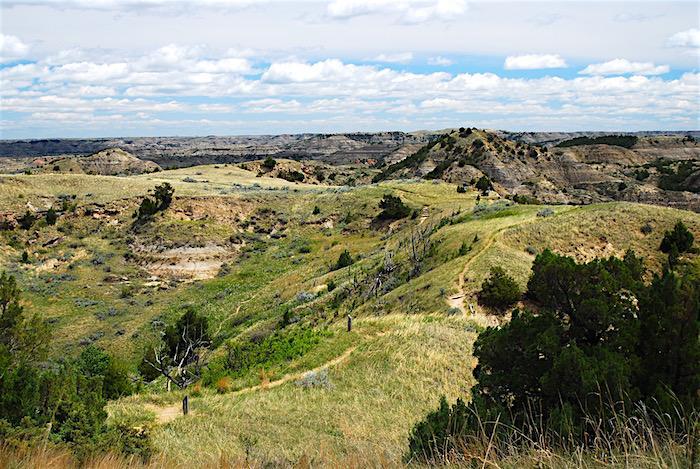
National Park Service officials are concerned that visibility at Theodore Roosevelt National Park could be impacted if there was a malfunction at an oil refinery proposed to be built three miles from the park's main entrance/Kurt Repanshek file
While National Park Service air quality analysts don't think an oil refinery proposed to be built three miles from Theodore Roosevelt National Park's entrance near Medora, North Dakota, would pose a problem under normal operating conditions, they are concerned that visibility could be impacted by "upset conditions" and want North Dakota officials to do additional review of the company's permit application.
Under upset conditions, which include system malfunctions or the abnormal release of emissions when capture units are offline, "emissions of SO2 could be 500 times greater, emissions of acid gas (H2S) could be 50 times greater, and emissions of NOx could be 12.5 times greater during these periods compared to normal operation," the Park Service's technical comments noted.
"While the NPS air analyses based on annualized flaring emissions did not indicate significant park impacts, we request that the ND DoH evaluate the impacts and possible mitigation of upset conditions when emissions could dramatically increase at the proposed refinery," Theodore Roosevelt Superintendent Wendy Ross noted in her comments to the North Dakota Department of Health, which is reviewing Meridian Energy Group's permit application.
"We are also concerned about significant park air quality impacts during upset conditions at the proposed refinery," she added. "These conditions and their impact have not been well-characterized. We request additional information, modeling, and analysis of air emissions during upset conditions."
Meridian officials maintain that they can build a refinery that will "exceed North Dakota’s most stringent air quality regulations." The company specifically is seeking a Minor Synthetic Source Permit, rather than a major-source permit, for a refinery capable of producing 55,000 barrels of fuel products per day. The difference in the two permits comes down to emissions; Meridian officials believe they can operate the cleanest refinery ever built.
Meridian also is proposing a gas-fired power plant to meet the refinery's energy needs.
Targeted for a 620-acre swath of farmland between Belfield and Fryburg just east of Theodore Roosevelt, the refinery project is just the latest industrial development pressing in on the 70,447-acre national park. The U.S. Forest Service back in 2015 gave the OK for a 25-acre gravel pit across the Little Missouri River from Theodore Roosevelt's historic Elkhorn Ranch and roughly 25 miles from the core of the park's South Unit, while oil pumps dot the landscape in just about every direction. From Buck Hill in the park's South District, gas flares from fracking operations outside the park stand out at night.
Superintendent Ross also expressed concerns about possible expansions of the refinery from its currently proposed scope.
"We are concerned about additional future impacts to Theodore Roosevelt National Park if Meridian Energy Group decides to expand or increase production at the proposed facility. We request that the ND DoH require additional permit review and public input prior to any expansion or increase in production at the proposed facility," she wrote.
The park, of course, was named after Theodore Roosevelt, who came to this landscape as a young man and discovered his conservation bent. The Elkhorn Ranch was where he recovered from the deaths of his wife, Alice, two days after giving birth to their daughter, and his mother on the same day, Valentine's Day 1884. The ranch setting remains bucolic today. While the ranch house is gone, there still stand some of the cottonwood trees that shaded the house and the porch from which the young Roosevelt would escape the heat with a book or simply to rock in his chair while taking in the Little Missouri and the badlands that it carved into the landscape.
The North Dakota Health Department received more than 11,000 comments on Meridian's permit application, though almost all of those were generated by National Parks Conservation Association members acting on the organization's "action alert" about the plant. Department officials expect it will take about two months to review the comments.



Add comment